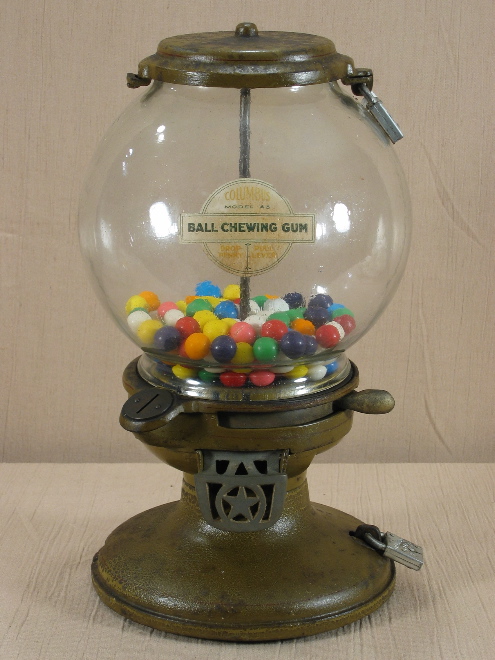___________________________________________________________________________________________
Columbus Model A-3

___________________________________________________________________________________________

Columbus Vending Company, Columbus, OH, c. 1915, 15". This model is so similar to the Model K that it took me years to figure out the difference. To be more accurate, the difference is apparent, but from the descriptions in Silent Salesmen Too I couldn't figure out which was the Model A-3 and which was the Model K. Part of that confusion derived from what I believe is a mistake in the book . . . . but more on that in a minute.
The Model A-3 is a cast iron gumball vendor. It uses a mechanism similar to that of the Model A, except the vending wheel has a single hole for a gumball rather than a quadrilateral for bulk product. When you look down through the top you see that hole, the part of the aluminum vending wheel that surrounds that hole, and the top piece of the midsection, which is big and which covers most of the vending wheel (as does this piece in a Model A). Most of the gumballs sit on that cast iron piece. Put a penny in, pull the lever over, and the gumball vends from the hole, after which the spring-loaded vending wheel returns to its starting position. If you pull the lever without putting the penny in, it slides a little to the left and then stops---again, like that of the Model A. The small round smooth globe is correct, as are padlocks; this model stopped being made long before barrel locks were developed.
Silent Salesmen Too says "this forerunner to the Moel K was short-lived." Because of this sentence and because I never saw one early in my collecting years, I'd always thought of this machine as very scarce. However, I've seen a handful available over the last 2 or 3 years and have come to believe that they're more plentiful than I'd thought. The one pictured in the book has a cam-lock lid, but I know of only one like that. I don't think that's the one pictured in the book, though, so it's not the only one. It's a tough lid to find, though. All the A-3's I've seen with original paint range in color from lime-khaki green to a burnt orange that had a beautiful, rich, deep patina.
The Model A-3's I've seen have a slanted coin entry, which leads me to the mistake in Silent Salesmen Too. Under "Model A-3" you'll see an A-3 with a slanted coin entry. Under "Model K" you'll see 2 examples; a porcelainized version with a straight coin entry and a painted version with a slanted coin entry. As I started coming across machines that I knew to be either A-3's or K's, I couldn't figure out which was which. Part of my confusion was that I was comparing the machines I had to the Model A-3 and the painted Model K pictured in the book, but I now think that the painted Model K in the book is actually a Model K. I vaguely remember a collector telling me once that Bill knew about the mistake and had told this collector about it, but I can't remember the details of that conversation (including, unfortunately, the collector who told me).
Given all that, I think there are 2 easy ways to distinguish a Model A-3 from a Model K:
The example pictured above is 100% original, and has a decent story behind it. I got this from a friend named Richard who lives in South Carolina. He tripped across it in the mid-1990's in a town in North Carolina. The store is in the historic district of a town popular with tourists, and is an old, refurbished pharmacy-turned-lunch counter that has hungry diners in the middle and apothecary and general store items displayed for sale around its perimeter. Richard and his wife were road-tripping around the southeast and ended up in this store. They saw 2 machines: A Columbus M and the Columbus A-3 pictured above. He asked how much, and the owner said "$500 each." Richard was a fairly new collector and didn't have the confidence he developed later, so he wondered what was wrong with the machine or with his perception of value---because he thought the A-3 was worth a whole lot more than the Model M. After thinking a bit more about it, he overcame his uncertainty and bought the A-3 while leaving the M behind. The way Richard told the story, the store owner was a smug curmudgeon who was sure he was taking advantage of Richard's naivete. His approach pissed Richard off a bit, but Richard didn't feel too badly abused; after all, he got the machine, didn't he?
A couple of years after this episode I passed through the town and stopped in the same store. The Model M was still there, the price was still $500, and the owner was still a smug curmudgeon who told me that the price was a deal because the machine was worth much more than $500. In fact, he said, in a town with a large tourist trade, like his town had, he was sure it would sell quickly at that price. I passed anyway, and have managed to not kick myself too often for that decision.
Many thanks to Roy Leatherberry for his critical review of this page.
___________________________________________________________________________________________
___________________________________________________________________________________________
©Small Vintage Vending 2003-2009